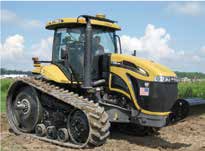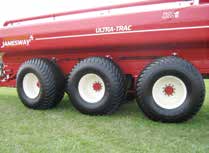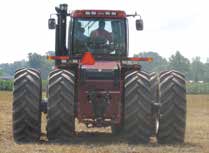chAPter 15 Preventing and lessening CoMPaCtion
Figure 15.5. Left: Subsoiler shank provides deep compaction relief (wings at the tip provide lateral shattering). Right: Zone building provides compaction relief and better rooting with minimal surface disturbance. Right photo by George Abawi.
be harmful for those soils, especially if the deep tillage
damaging. The main criteria should be:
was performed when the subsoil was wet and caused
• the soil moisture conditions when the traffic occurs;
smearing, which may generate drainage problems. After
and
performing deep tillage, it is important to prevent future
• the relative compaction effects of various types of
re-compaction of the soil by keeping heavy loads off
field traffic (mainly defined by equipment weight
the field and not tilling the soil when inappropriate soil
and load distribution).
moisture conditions exist.
For example, with a late-planted crop, soil moisture
Better attention to working and traveling
conditions during tillage and planting may be generally
on the soil. Compaction of the plow layer or subsoil
dry, and minimal compaction damage occurs. Likewise,
is often the result of working or traveling on a field
mid-season cultivations usually do little damage,
when the soil is too wet (figure 15.6). Avoiding this may
because conditions are usually dry and the equipment
require equipment modifications and different timing
tends to be light. However, if the crop is harvested
of field operations. The first step is to evaluate all traf-
under wet conditions, heavy harvesting equipment and
fic and practices that occur on a field during the year
uncontrolled traffic by trucks that transport the crop off
and determine which operations are likely to be most
the field will do considerable compaction damage. In
Figure 15.6. Compaction and smearing from wet (plastic) soil conditions: wheel traffic (left), plowing (middle), and zone building leaving open and smeared slot (right).
166
Building SoilS for Better CropS: SuStainaBle Soil ManageMent









